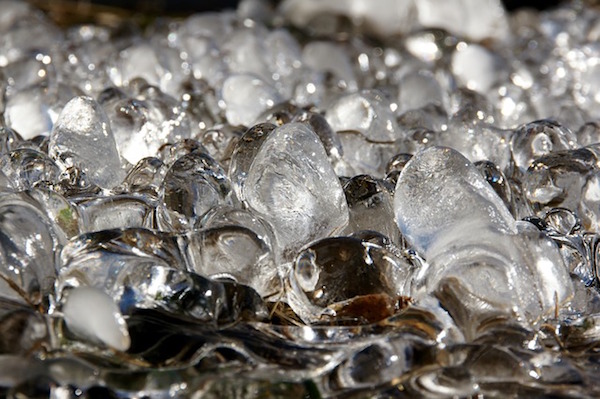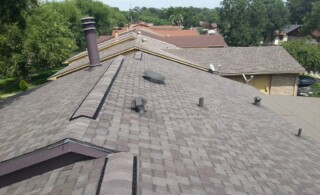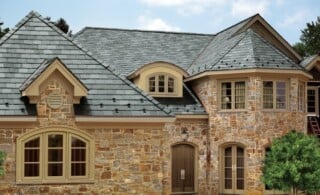
Every few winters cities are plagued by ice dams. They generally appear after a heavy snowfall during an extended period of cold temperatures. Because ice dams occur on roofs buried in snow, few people actually see them, let alone understand their causes.
The only time people think about them is when they occur, which is about the only time that almost nothing can be done.
What are Ice Dams?
Ice dams are literally dam-like buildups of ice on a roof. They normally occur at the edge of the roof but can occur higher up under certain circumstances.
The ice itself is not a problem. What is a problem is that melt water from the snow can form a pool behind the dam. Most roofs are very effective at shedding water. Very few roofs, however, are designed to cope with pools of water. Water backs up behind the ice, seeping up under the shingles until it finds its way through the roof to the attic and living areas below.
While usually temporary in nature, the massive roof leaks the dams cause can wreak all kinds of havoc with wiring, drywall, paint, carpet, flooring and interior furnishings. Ice damming can also cause problems for your exterior siding and the wood and insulation behind it.
What Causes an Ice Dam?
Ice dams occur most often when we get heavy snow followed by below freezing temperatures, but they can occur with just an inch or two of snow. Some part of your roof warms up enough to melt the snow. The melt water flows down to another part of the roof that is cooler, and the water refreezes. The ice forms a small dam that builds up slowly as more melt water refreezes. Eventually, water backs up behind the dam and works its way up under the shingles until it begins to leak through the roof into the living space below.
There are four main causes of ice damming, and the latter three we can actually do something about.
- Weather
- Household heat escaping to the attic
- Uneven roof temperatures
- Roofing underlayment that water can penetrate
Preventing Ice Dams
Ice dam prevention is best achieved in three ways:
- Attic insulation
- Attic ventilation
- Proper re-roofing
Attic Insulation
While some warm spots on the roof occur because of sunlight, most are caused by heat escaping from the heated portions of the house. Most homes have attic insulation, but in many cases there isn’t a sufficient amount or the insulation has settled, been compressed, gotten wet, or has otherwise become less effective. In many homes the problem is breaks or gaps in insulation due to light fixtures, pipes, settling, or foot traffic. The goal is to have an attic that stays very close to outdoor temperatures.
Pull-down attic stairs and other access doors are often quite leaky. Weather-stripping or building a double door (analogous to a storm door on the front of a house) can help seal up these access points.
In many homes, heating ducts run through the attic to reach other parts of the home. If the ducts themselves have a leak or if they are insufficiently insulated, the leaking heat can cause an ice dam.
Some older homes have bathroom or kitchen exhaust fans that blow warm and/or moist air into the attic. These exhausts can be a problem because, in addition to leading to warm spots, the moisture reduces the effectiveness of the rest of the attic’s insulation. All exhaust ducts should be vented to the outside.
Attic Ventilation
Even a well-insulated attic is likely to have some heat escaping from the house. It is also likely to be affected unevenly by sunlight. Proper ventilation can smooth out temperature variations and largely eliminate the risk of ice dams.
Ready to start your ice dams?
Find ProsAttic ventilation is usually the easiest way to prevent ice damming, yet it is the step most often omitted. Most attics are designed to take advantage of the fact that heat rises. Air must be able to circulate freely under the roof.
In a typical home, there is a series of vents under the soffits or eaves. These vents are the intake vents in your attic’s ventilation system. People sometimes cover these up on the outside, not fully understanding their importance. Sometimes these vents get clogged with dust, vines, leaves, or other debris. If you don’t have these vents, have a carpenter or roofer install them. If you do have them, make sure they are clear of debris.
To be effective against ice damming, your attic ventilation needs to have a two-part system:
- Intake vents
- Exhaust vents
Warm air rises and escapes out of the exhaust vents, drawing fresh, cool air into the intakes. Ideally, this prevents any part of the roof from having the opportunity to become warmed by air escaping from the home below. Good ventilation also helps minimize variations in temperature due to sunlight.
While nearly all attics rely on intake vents at the eaves, the exhaust vents take any number of forms. The most common are square, round, or triangular vents the size of a pizza box located near the top of each gable. (The gables are the triangular sections of your home’s exterior walls just below the roof line at either end of the house.) These vents also need to be free of debris.
Some homes are equipped with a ridge vent, which is a long, often continuous vent that runs the length of the roof’s ridge (the roof’s peak). Some homes have heat-propelled ventilating turbines. Each turbine is a metal device shaped like a chef’s hat with spiraled slots in it and is mounted on the roof near the ridge. These turbines are designed to spin as air rises through them, but can become jammed due to dirt or storm damage. If the turbines don’t turn freely, they should be overhauled or replaced.
Many homes with adequate vents have poor air circulation due to obstructed air paths. This typically occurs near the eaves when new insulation is added or old insulation settles in a way that blocks the flow of air from the intake vents to the rest of the attic. There should be at least an inch and a half of space between the insulation and the roof inside the attic at the eaves. There should be no insulation on top of the intake vents themselves.
Re-Roofing Strategies
The final line of defense in your home’s ice-dam prevention system is called a Waterproof Shingle Underlayment (WSU). This is a special kind of self-sealing asphalt/polymer sheet placed on the roof before shingles are installed. Unlike standard roofing felt or tar paper, this membrane remains waterproof even when nails are hammered through it. Any time you have a new roof put on, ask for this material to be installed at the gutter edge of the roof and along the valleys where two surfaces of the roof meet. Should an ice dam occur in one of these areas, the WSU should prevent the water from getting into the home.
 Will Your Roof Cost You Thousands This Winter?
Will Your Roof Cost You Thousands This Winter?  Best Asphalt Shingles – A Buyer’s Guide
Best Asphalt Shingles – A Buyer’s Guide  Best Cities for Sidewalks and Winter Safety
Best Cities for Sidewalks and Winter Safety  Spring Garden Flower Tips and Suggestions
Spring Garden Flower Tips and Suggestions  For Reduced Energy Costs, Try a Reflective Roof Coating
For Reduced Energy Costs, Try a Reflective Roof Coating 

Ceiling fell in over the kitchen pantry. I can replac dry wall but is it a roofing problem?